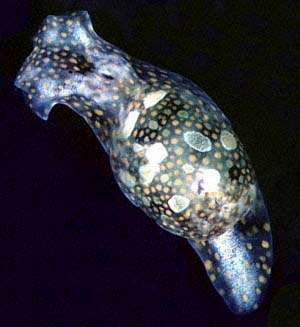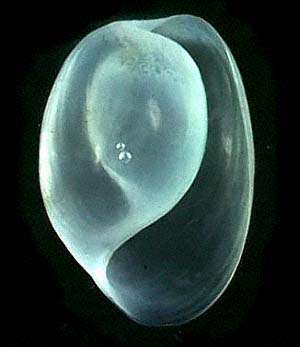

Haminoea ovalis
Pease, 1868
Order: CEPHALASPIDEA
Superfamily: HAMINOEOIDEA
Family: Haminoeidae
DISTRIBUTION
Tropical western Pacific?
PHOTO
UPPER: Guam, Bile Bay, Guam. Reef flat; 10.5mm long alive; 10 July 1971.
LOWER: shell (6.5 x 4.6mm) from <10mm long living specimen.
PHOTOS: Clay Carlson & Patty Jo Hoff.
"As far as we know, this is Haminoea ovalis Pease, 1868. As with Haminoea sp. 1 it differs from H. cymbalum in terms of color, shell shape, gizzard plates and radula. H. ovalis is the only Haminoea proper that we are aware of that has all lateral teeth denticulate. Host is the blue-green algae, Lyngbya majuscula".
Note from Clay Carlson & Patty Jo Hoff. (see message below.
See also Haminoea sp. 2. and Haminoea sp. 3.
See Carlson & Hoff's message discussing the 5 orange-spotted species.
Rudman, W.B., 1999 (March 21) Haminoea ovalis Pease, 1868. [In] Sea Slug Forum. Australian Museum, Sydney. Available from http://www.seaslugforum.net/find/hamioval
Related messages
Haminoea ovalis from Heron Island
April 20, 2005
From: Julie Marshall

Dear Bill,
This species seems to be Haminoea ovalis although it seems to be a very variable species. Bob Burn found three specimens whilst sieving algae from coral clumps on the reef flat at Heron Island [Great Barrier Reef] at low tide. They ranged in size from 3 to 7 mm. The two better photos are of a 3 mm animal which has only a few blackish-dark purple spots; the other photo (unfortunately not a good one) was of a 7 mm animal and as you can see it had many more dark spots. Apart from the dark spots it is very similar to Haminoea cymbalum
[H. simillina?] which I used to find in very large numbers on algae at the reef crest at Heron Island at low tide, but this species never had dark spots. In recent years the Chlorodesmis and other algae on which they were found has largely disappeared from the reef crest (possibly due to the higher water temperatures over the last couple of years) and they are now rarely seen.
Locality: Heron Island, Great Barrier Reef, Queensland, Australia, Pacific Ocean. Depth: Intertidal. Length: 3 mm and 7 mm. 19 March 2005. Intertidal. Photographer: Julie Marshall
Best wishes,
Julie Marshall
juliemarshall@netspace.net.au


Thanks Julie,
As we have discussed on the Forum before, we still seem to have a way to go before the orange-spotted haminoeids make sense - or at least can be identified.
Best wishes,
Bill Rudman
Re: Haminoea ovalis from Samoa
March 23, 2000
From: Clay Carlson
Bill,
Concerning your earlier comment, I imagine Garrett was drawing what he 'saw'. When an orange spot occurs over a purple blotch, the orange does appear to have a dark ring. I don't imagine that either Garrett or Pease had the optics nor the lighting that we can carry into the field today. Patty Jo and I have an old dissecting scope that practically always goes into the field with us. It makes a big difference when there are relatively complete color notes on many of the small forms -- especially when the slides don't turn out too well.
Clay
clay.carlson@kuentos.guam.net
Carlson, C., 2000 (Mar 23) Re: Haminoea ovalis from Samoa. [Message in] Sea Slug Forum. Australian Museum, Sydney. Available from http://www.seaslugforum.net/find/2139Re: Samoan Haminoea
March 20, 2000
From: C.Carlson & P.J. Hoff

Bill,
Sorry for the delay. We thought we would have some additional info, but didn't get to it.
We have not seen an ovalis-like animal with the underlying color as found on the Samoan specimen. The orange spotting is close to that we find on the Guam animals and the gray would be the purple. The purple can be quite variable, some juvenile forms being mostly purple. Conclusion: probably H. ovalis (id warranted for 72 hours). As with many of the haminoeid forms, it is best to take a look at the animal.
I have attached a scan of the H. ovalis plate (Pease, 1868; Plate 7, fig.
2). I believe the drawing was done by Andrew Garrett. The original color description was: "Animal pale watery green, closely dotted with orange and purple. The portion seen through the shell is spotted obscurely with cream yellow, their margins powdered with white. Foot cream white, remotely dotted with pale orange. ..." (Pease, 1868:72)
Clay & Patty Jo
clay.carlson@kuentos.guam.net
Carlson, C. & Hoff, P.J., 2000 (Mar 20) Re: Samoan Haminoea. [Message in] Sea Slug Forum. Australian Museum, Sydney. Available from http://www.seaslugforum.net/find/2115Dear Clay & Patty Jo,
Thanks for the input. Pease make no mention of the black rings which are in the panting but not in his description. Perhaps they were just Garrett's way of showing the white ring around each orange spot.
Best wishes,
Bill
Haminoea ovalis? from American Samoa
March 6, 2000
From: Don Barclay


Hi Bill,
I went "red bubble" hunting last night, but didn't find any. I did find a pair of bubbles, though, of a different sort. They look closest to the photos of Haminoea ovalis to me, though I'm not entirely sure what external characteristics distinguish Clay and Patty Jo's Haminoea sp. 3. These did have greyish spots on and behind the head, but not really purple ones, and these dark spots appeared to be under the surface rather than external coloring. The larger animal was 12mm long, and the smaller one 9mm. The only noticeable difference was that the small orange spots appeared a bit more widely distributed on the larger animal, and the smaller one had fewer dark spots.
They were both collected in the same area where the Bullina sp. 1 was collected, on a coral head covered with Halimeda patches, reddish-orange coralline growths, and mossy green algae that may be the blue-green algae, Lyngbya majuscula, that Clay refers to. They were collected just after midnight, early morning of 2 March 2000, in one meter of water, Utulei village, west Pago Pago Harbor, American Samoa. The attached photos are of the 12mm specimen. Haminoea ovalis?
Thanks as always,
Don.
n5ols@samoatelco.com
Barclay, D., 2000 (Mar 6) Haminoea ovalis? from American Samoa. [Message in] Sea Slug Forum. Australian Museum, Sydney. Available from http://www.seaslugforum.net/find/2030Dear Don,
I think I'll leave Clay to comment on your Haminoea.
I will be having a look at your Bullina sp.1 specimen this week so should be able to let you know something about it in a few days.
Best wishes,
Bill Rudman.
